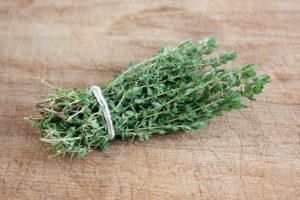Thyme adds a spicy note to soups, stews, tomato and wine-based sauces, dried bean dishes, stuffings, and stocks. It can be used in marinades for pork and game and also in chowders, gumbos, and jambalayas.
What this says is that thyme can take a long, slow cooking and—unlike other herbs—still bring something special to the table.
Some cooks say thyme is the one herb they can’t do without.
To the nose, thyme is peppery and earthy. To the palate, it is spicy with hints of clove, mint, and camphor.
Thyme is a constant in many herbs blends: it combines well with allspice, basil, bay, chili, clove, garlic, lavender, marjoram, nutmeg, oregano, paprika, parsley, rosemary, and savory. Some would call thyme a “background” herb because it rarely takes the front stage but gives complexity to many kitchen preparations.
There are dozens of varieties of thyme. The best known are no doubt common thyme and lemon thyme.
Common thyme and lemon thyme
Common thyme which is also known as garden thyme and includes the broad-leafed English thyme and the narrow-leafed French thyme is the one cooks draw upon most often. This is the foundation herb in seasoning mixes.
Lemon thyme—with its mauve flower and lemony flavor—is perfect combined with fish and seafood, roast chicken, and veal.
The best time to get to know thyme is in the summer when you will find its many varieties available fresh at the farm market. The start of summer is when you will find thyme blossoms as well. You can find dried thyme—both leaf and powder forms—year-round.
Ways to use thyme
Thyme is known as the “blending” herb because it pulls flavors together. Use leaves with beef, pork, poultry, seafood, sausages, vegetables, lentils, cheeses, eggs, rice, grains, bread, beans, stuffings, and soups.
Add thyme to stocks, marinades, and sauces. Use flowers in salads or as garnish. Include thyme with parsley, bay, and rosemary leaves to form a bouquet garni (a small bundle of heaves used to flavor sauce or stock.

How to choose thyme
Select fresh thyme with bright-colored leaves. When crushed the leaves should be fragrant. Avoid leaves that are wilted, dried out, or black.
How to store thyme
Keep thyme in the refrigerator for up to 2 weeks in a plastic bag. Bunch them together and hang them to dry, or strip the leaves and dry them on a screen. Dried thyme will keep for 3 months. Thyme freezes well in air-tight containers or bags.
Thyme flavor partners
Thyme has a flavor affinity for anchovy, chicken, clams, cream sauce, eggs, fish, lamb, lentils, mussels, onion, pork, potato, salmon, seafood, tomato, turkey, and zucchini.
Varieties of thyme
Here are varieties of thyme with their botanical names and descriptions:
- Common thyme (Thymus vulgaris): grows 6 to 10 inches tall (15-38cm); tiny, oval, pointed, aromatic gray-green leaves.
- Creeping thyme (T. praecox subsp. arcticus): height to 4 inches (10 cm); forms dense, dark green groundcover; flower color (rose, purple, crimson, or white) varies with cultivar; also called mother-of-thyme and used in herb mixes.
- Lemon thyme (T. x citriodorus): height to 12 inches (30 cm); leaves are dark green or variegated, glossy, and lemon-scented; combines well with chicken or fish dishes.
- Bushy French thyme (T. vulgaris): also called common thyme sweeter than English thyme with gray-green foliage. Dark green on the upper side and whitish underneath with a warm, sharp taste.
- Caraway thyme (T. herba-barona): 1 inch (2.5 cm) tall and especially good in stir-fry and meat.
- Nutmeg thyme (T. herba-barona): adds a nutmeg note to cooking.
- Silver thyme (T. vulgaris ‘Argentus’): has a strong lemon scent, excellent for cooking.
- Orange thyme (T. vulgaris ‘OrangeBalsam) narrow, orange-scented leaves are good with stir-fries and poultry.
About thyme
Thyme is a member of the mint family and is mostly native to southern Europe and the Mediterranean. But there are varieties of thyme native to many other regions of the world, from Greenland to Asia.
Most thymes–including garden thyme and lemon thyme–are small prostrate sub-shrubs with tiny, oval, pointed, gray-green leaves ¼ inch (6 mm) long on wiry stems. They usually stand from 12 to 15 inches (30-38 cm) tall. There are creeping and prostrate thymes—such as woolly thyme—that never grow more than 1 inch (2.5 cm) tall.
Thyme has been known since ancient times. The Greeks and Romans used time for both its aromatic and medicinal properties. The ancient Egyptians used it to embalm the dead. By the Middle Ages, thyme was being used as a flavoring for foods and drink.
In cookery, thyme is used in Middle and Near Eastern cuisines, and in Europe, the United States, and the Caribbean.
In the garden, thyme is an important companion plant to eggplants, potatoes, strawberries, and tomatoes. It is said to repel cabbage worms and whiteflies.
The word thyme is derived from the Greek thumos which means odor and refers to the plant’s fragrance.
The botanical name for common thyme is Thymus vulgaris.
Articles of interest:
Best Herbs for Container Growing
Garden Planning Books at Amazon:
- Vegetable Garden Almanac & Planner
- Kitchen Garden Grower’s Guide Vegetable Encyclopedia
- Vegetable Garden Grower’s Guide
- Tomato Grower’s Answer Book
More kitchen tips:
Bring your harvest to the table. Kitchen prep tips and easy recipes for the vegetables you grow. Click below for vegetable prep and recipes you can use now.
- Almonds
- Apples
- Apricot
- Aprium
- Artichoke
- Arugula
- Asparagus
- Avocado
- Bamboo Shoots
- Banana
- Basil
- Beans, Dried
- Beans. Long
- Beans, Shell
- Beans, Snap
- Beets
- Bitter Melon
- Blackberry
- Bok Choy
- Broccoli
- Broccoli Raab
- Brussels Sprouts
- Cabbage
- Cardoon
- Carrots
- Cauliflower
- Celeriac
- Celery
- Chard
- Chayote Squash
- Cherimoya
- Cherries
- Chestnut
- Chickpea
- Chinese Cabbage
- Chives
- Cilantro
- Citron
- Clementine
- Collards
- Coriander
- Corn, Sweet
- Corn, Baby
- Corn Salad, Mache
- Cranberry
- Cress
- Cucumber
- Daikon
- Dandelion
- Dill
- Eggplant
- Endive, Belgian
- Endive and Escarole
- Fava Beans
- Fig
- Florence Fennel
- Garlic
- Ginger
- Grapefruit
- Grapes
- Guava
- Horseradish
- Jerusalem Artichoke
- Jicama
- Jujube
- Kale
- Kiwifruit
- Kohlrabi
- Kumquat
- Leeks
- Lemongrass
- Lemons
- Lettuce
- Lime
- Mache (Corn Salad)
- Mandarin Orange
- Mango
- Maple Syrup
- Marjoram
- Melons
- Michihili
- Mint
- Mizuna
- Mushrooms
- Mushrooms, Cremini
- Mustard Greens
- Napa Cabbage
- Nectarine
- Okra
- Olives
- Olive oil
- Onions
- Oranges
- Oregano
- Parsley
- Parsley Root
- Parsnips
- Passion Fruit
- Pawpaw
- Peaches
- Pears
- Peas, Garden Snap
- Peas, Snow
- Pei Tsai
- Peppers, Chili
- Peppers, Sweet
- Persimmon
- Pineapple
- Pineapple Guava
- Plantain
- Plums
- Pluots
- Pomegranate
- Potatoes
- Prickly Pear
- Pumpkin
- Quince
- Radicchio
- Radishes
- Raspberries
- Rosemary
- Rhubarb
- Rutabaga
- Sage
- Salsify
- Sauerkraut
- Savory
- Shallots
- Sorrel
- Spinach
- Squash, Summer
- Squash, Winter
- Strawberries
- Sunchokes
- Sunflower
- Sweet Potato
- Swiss Chard
- Tangerine
- Taro
- Tarragon
- Thyme
- Tomatillo
- Tomato
- Turnip
- Turnip Greens
- Yams



